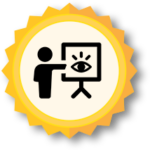Scholarship of Teaching and Learning
 Overview and Introduction: The WHAT and WHO
Overview and Introduction: The WHAT and WHO
The Scholarship of Teaching and Learning (SoTL) involves continual reflection and systematic inquiry regarding students’ learning with the purpose of improving the courses or programs, followed by sharing the discoveries and best practices with a broader community. It is a philosophy that invites the faculty to apply research and explore opportunities for developing their teaching practices and to connect with a community of peers sharing the same goal [1]–[3].
The concept of SoTL started with the work of Ernest Boyer in 1990, who discussed in his book, entitled Scholarship reconsidered: Priorities of the professoriate, the different functions of the professoriate [4]. Boyer presented four types of scholarship: 1) The scholarship of discovery, which is characterized by the advancement of knowledge through research; 2) the scholarship of integration, which is related to connecting research discovery across disciplines; 3) the scholarship of integration, which is connected to applying the research discovery to solve societal challenges; and 4) the scholarship of teaching (that evolved to SoTL), that is related to the development of ways to support students learning by bringing in a scholarly lens and inquiry into the classroom.
SoTL improves student learning by seeking to understand teaching practices. It also helps faculty to become more reflective teachers, improve their own practice, and demonstrate commitment to teaching [1, 3].

 Implementation and Timing: The WHEN, WHERE, and HOW
Implementation and Timing: The WHEN, WHERE, and HOW
The SoTL can appear time-consuming and overwhelming, however, similar to learning a new practice, it can be understood and implemented in a continual and progressive manner. In their book, entitled Transformative Teaching, Dr. Nadia Kellam [2] and others highlighted the importance of starting small and slow. A few tips and SoTL phases are shared below that encourage you to reflect on considering the “problem” you face in your classroom as an opportunity to begin a meaningful project, rather than a failure that needs to be completely addressed at once.
Rowlan and Myatt [3] graphically mapped (Figure 1) a SoTL project sequence to illustrate the stages and considerations of engaging in the SoTL.
Figure 1 – Rowlan & Myatt [5] Map of a SoTL project
- Phase 1: The initial stage consists in identifying potential projects through reflection on practical aspects of teaching, existing literature, and/or conversation with colleagues. Try to identify what is working well or what you would like to improve in your classroom.
- Example: There is an assignment that was designed for students to work in groups, but the groups are randomly assigned. You noticed that most of the groups tend to report issues among the group members that end up impacting their potential results. In this situation, questions like “How should the groups be formed?” or “What interventions could facilitate students to work with people they do not know?” may appear and be used as future research questions.
- Phase 2: This phase involves designing of the project with the identification of potential theoretical frameworks that may support the inquiry and methodological approaches.
- Example: For example, if you are interested in improving student engagement and learning, consider using the ICAP Framework [5]. The framework can help you design more engaging instructional activities and can help you to compare pre and post intervention engagement and/or learning.
- Phase 3: The next phase consists of data collection (implementation) and data analysis (assessment). In this phase, you will be able to identify improvements, limitations, and implications through data collection and analysis. For example, finding out that after the implementation of the curiosity journal, students passed to actively engage in the classes.
- Example: In this phase you will gather classroom data (e.g., student surveys, student interviews or focus groups, assignments) and analyze them considering your research question and the theoretical framework. After the analysis you would be able to identify which aspects improved with the intervention, which aspects continued to be the same, and how the intervention could be improved in other iterations or other settings.
- Phase 4: The last stage is the dissemination of the findings and experiences. Dissemination is a fundamental part of the SoLT, it is necessary to share and learn from the broader community to continue to improve teaching.
- Example: Some examples of dissemination venues are the Journal of Engineering Education, Advances of Engineering Education, International Journal of Engineering Education, and Engineering Education Conferences such as the American Society of Engineering Education Conference and Frontiers in Engineering Conference. Additional publishing venues include The Journal of the Scholarship of Teaching and Learning, Active Learning in Higher Education journal and the Learning and Instruction journal.
Overall, the SoTL is about an innovative mindset, often student-centered, that allows students to actively participate in the learning process and instructors to reflect on their teaching methods, experiment with new techniques, and refine their strategies through evidence-based techniques.

 Rationale and Research: The WHY
Rationale and Research: The WHY
The SoTL promotes continual improvement of teaching methods. This results in more effective teaching strategies that enhance student engagement as well as understanding and retention of course material. When instructors are actively engaged in assessing and improving their teaching methods, they are more likely to seek feedback from students and respond to their needs. The increased interaction between instructors and learners leads to more personalized learning experiences for students with increased sense of belonging. When students perceive that their instructors are committed to their success, it can also have a positive impact on their motivation. Instructors also benefit from engaging in the SoTL by more effective teaching approaches, increased work satisfaction and potential career advancement opportunities through excellence in teaching, publications, presentations, and collaboration with other researchers [6-8].

 Additional Resources and References
Additional Resources and References
[4] E. L. Boyer, Scholarship reconsidered: Priorities of the professoriate. Princeton University Press, 1990.
[5] M. T. H. Chi and R. Wylie, “The ICAP Framework: Linking Cognitive engagement to active learning Outcomes,” Educational Psychologist, vol. 49, no. 4, pp. 219–243, Oct. 2014, doi: 10.1080/00461520.2014.965823.
https://nancychick.wordpress.com/sotl-guide/
https://www.facultyfocus.com/articles/teaching-and-learning/inquiry-into-the-college-classroom/
